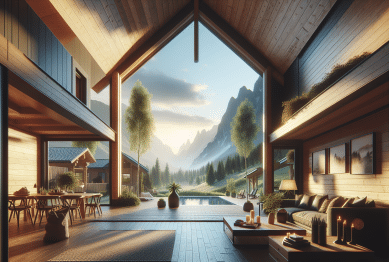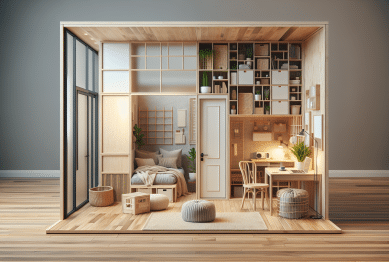Curious about minimalist lifestyles, sustainable decor, and how tiny homes keep winning hearts? Uncover the essentials of tiny home living trends, discover practical space-saving hacks, and learn how this lifestyle influences everything from design to daily routines. Get a closer look at how people are redefining comfort and sustainability in compact spaces.
Tiny Homes and the Minimalist Revolution
The surge in tiny home living can be traced back to a desire for simplicity. Many people now seek minimalist lifestyles, embracing less clutter and more purpose. Compact home design doesn’t just mean downsizing—it means shaping a lifestyle around essentials, space efficiency, and conscious consumption. This movement appeals to those who want less distraction and more intention in their day-to-day lives. It often opens the door to financial freedom and less environmental impact, which resonates strongly with today’s eco-minded generations. Rather than chasing after larger houses, the focus has shifted to making the most of what’s truly needed for comfort and practicality in everyday living. Individuals drawn to minimalist ideals often cite reduced stress and greater satisfaction with their living environment (Source: https://www.nps.gov/articles/going-green-with-tiny-homes.htm).
This lifestyle shift isn’t merely about saving money or space. It reflects changing values in society, where environmental sustainability, flexibility, and creativity take center stage. Tiny home living allows people to break free from traditional mortgage models while rediscovering community and sustainability. The benefits of living small are evident: lower utility costs, easier upkeep, and the ability to live in unique locations. Tiny home owners often mention that the sense of coziness is irreplaceable, especially when every element in their space is curated with care and intention.
Minimalist living is not without its learning moments. Adjusting to fewer belongings and a smaller footprint can feel restrictive at first. With time, most discover a sense of freedom rarely found in larger homes. The opportunity to personalize every corner becomes a form of self-expression, supported by sustainable choices and multi-functional furniture. Social media has amplified these stories, fueling curiosity and inspiring new designers to craft creative micro-living solutions. Today, the minimalist revolution is at the heart of lifestyle and entertainment conversations around the globe.
Designing for Small Spaces: Creativity in Action
Tiny home living demands innovative design strategies. Every square foot has potential to become multi-purpose, making smart storage solutions and modular furniture essential. Questions about how to optimize compact home design with style and function spark the imagination of enthusiasts and architects alike. Popular trends include transforming furniture, hidden compartments, and vertical shelving—creative touches that ensure small homes pack a big punch in both comfort and usability. These solutions encourage residents to rethink traditional room divisions, integrating living, dining, and work areas with seamless flow. Such flexibility also enables a more dynamic and personalized environment (Source: https://www.nahb.org/Advocacy/Industry-Issues/Tiny-Homes).
Open floor plans are another hallmark. Eliminating unnecessary barriers creates a sense of spaciousness, even in homes under 400 square feet. Windows are strategically placed to maximize natural light and bring the outdoors in, enhancing the sense of space. Fold-away desks, beds that double as seating areas, and kitchens with expandable counters are just a few ways homeowners can make the most of minimal interiors. The challenge sparks plenty of creativity: there’s an endless stream of inspiration in online communities and lifestyle publications, fueling the desire to innovate.
Sustainability also plays a big role in design choices. The careful selection of eco-friendly materials, energy-efficient lighting, and water-saving appliances aligns tiny homes with the philosophy of conscious consumption. Homeowners often repurpose salvaged wood, upcycled metals, and reclaimed fixtures to create welcoming, unique spaces. Many take pride in showing how sustainable design not only reduces their carbon footprint but also adds beauty and character to their homes. With thoughtful planning, tiny living proves that less square footage doesn’t mean sacrificing comfort or aesthetics.
Sustainable Decor and Eco-Friendly Innovations
Decor in tiny homes is all about intention and sustainability. Rather than filling every inch, the emphasis is on choosing pieces that serve double duty, last long, and have minimal impact on the planet. Essentials like furniture made from renewable resources, low-VOC paints, and recycled textiles are increasingly favored. These elements keep tiny home living fresh, aligning with growing concerns about environmental responsibility. Small changes, such as using solar-powered lighting and composting toilets, not only save energy but also reduce long-term costs. This commitment to ecological decor choices sets tiny homes apart from more traditional dwellings (Source: https://www.energy.gov/eere/solar/articles/solar-ready-tiny-homes).
Plants are another favorite decorating tool. Not only do they purify the air and infuse color, but they also add a natural touch without consuming precious floor space. Vertical gardens, hanging planters, and window boxes are perfect for limited areas. Eco-friendly innovations, like rainwater harvesters, green roofs, and composting stations, further reinforce the compact home’s commitment to harmony with nature. Every sustainable choice is a chance to express creativity and environmental stewardship.
The upcycling culture thrives in tiny home decor. Owners often transform old ladders into shelves, repurpose crates as storage, or turn vintage suitcases into coffee tables. These DIY projects showcase personal style and resourcefulness, helping to keep budgets lean while reducing waste. Social media platforms highlight such efforts, turning simple sustainability hacks into inspiring trends. The ripple effect is clear: as tiny home culture grows, so does a new standard of mindful decorating that resonates beyond small living itself.
Daily Life in Compact Living Spaces
Daily routines in a tiny home look a bit different. With less space to clean and maintain, many find themselves with more time for hobbies, nature walks, or community events. The simplicity encourages reevaluating what’s essential and letting go of things that no longer add value to daily life. This mindset extends into meal planning, entertainment, and even work arrangements. People are more likely to shop intentionally, buy higher-quality groceries in smaller amounts, and invest in experiences rather than things. It’s not just about living with less; it’s about living with purpose and joy (Source: https://www.apa.org/monitor/2020/01/calm-clutter).
Social interactions also change. With fewer places to hide clutter, tiny homeowners often adopt a tidy-as-you-go philosophy. Entertaining small groups is easier, and outdoor spaces become extensions of the home—perfect for impromptu gatherings or quiet evenings under the stars. Some people choose to stay mobile by living in tiny homes on wheels, traveling between destinations, and exploring a lifestyle that balances adventure with belonging. This adaptability makes tiny living appealing to digital nomads, retirees, and families alike.
Of course, adjusting to compact spaces requires flexibility and patience. Storage solutions need regular rethinking, privacy must be negotiated, and everyone shares responsibility for keeping the space functional. For couples and families, tiny home living can strengthen communication and teamwork, inspiring new routines and traditions. Many express gratitude for the deeper bonds and shared memories that naturally arise in small, thoughtfully organized homes.
Entertainment Trends and Social Influence
The tiny home movement is now a staple in lifestyle and entertainment media. Television series, digital documentaries, and influencer channels spotlight the journey of creating and living in these unique spaces. Viewers are fascinated by the ingenuity and resilience displayed—transforming limited square footage into extraordinary environments. This exposure has sparked a global conversation about what comfort, home, and happiness really mean (Source: https://www.pewresearch.org/short-reads/2021/05/12/a-growing-share-of-americans-say-they-are-spending-more-time-at-home/).
Trendy hashtags and challenges invite social media users to share their smallest home hacks, creative storage ideas, and before-and-after transformations. These online communities offer camaraderie, encouragement, and real-world solutions for common tiny living obstacles. They can also expose the ‘downsides’ of micro-living, giving a balanced view and enabling prospective residents to make informed choices. As the movement grows, so does the appeal of authenticity and connection, rather than perfection.
Lifestyle magazines and YouTube channels regularly feature expert advice on decorating, organizing, and thriving in tiny spaces. The influence spreads beyond the homes themselves, shaping aspirations for green living, creative problem-solving, and a focus on personal well-being. People who follow these trends are often inspired to implement small-scale changes in their own spaces, even if they’re not living tiny—a testament to the broad appeal and lasting influence of this lifestyle trend.
Is Tiny Living Right for You? Exploring the Pros and Cons
Choosing tiny home living is a personal decision. While some are drawn to the freedom, simplicity, and lower costs, there are considerations to weigh before making the leap. Tiny living can mean big lifestyle shifts—requiring thoughtful planning, flexibility, and a willingness to adapt. Some appreciate how the change brings greater focus and emotional satisfaction. Others may find the constraints too challenging, especially when it comes to privacy or hosting guests (Source: https://extension.oregonstate.edu/es/forestry-fire/small-acreage/are-tiny-houses-right-you).
The pros are many: utility savings, less environmental impact, and a decluttered lifestyle are major draws. Maintenance takes less time, freeing residents for travel, hobbies, or community engagement. These benefits attract creative professionals, retirees, and adventurers alike. However, storage limitations, zoning laws, and the need for creative organization can be obstacles. Flexibility is key to overcoming small-space challenges and making the most of every nook and cranny.
Ultimately, the question is whether the rewards of tiny living align with personal values and circumstances. Many find the shift both liberating and eye-opening—an invitation to reflect on priorities and challenge the standard narrative of ‘bigger is better.’ As society continues to reassess what makes a house a home, tiny home living will remain a compelling and evolving trend within lifestyle and entertainment circles.
References
1. National Park Service. (2023). Going Green with Tiny Homes. Retrieved from https://www.nps.gov/articles/going-green-with-tiny-homes.htm
2. National Association of Home Builders. (2023). Tiny Homes. Retrieved from https://www.nahb.org/Advocacy/Industry-Issues/Tiny-Homes
3. U.S. Department of Energy. (2022). Solar-Ready Tiny Homes. Retrieved from https://www.energy.gov/eere/solar/articles/solar-ready-tiny-homes
4. American Psychological Association. (2020). Calm the Clutter. Retrieved from https://www.apa.org/monitor/2020/01/calm-clutter
5. Pew Research Center. (2021). A growing share of Americans say they are spending more time at home. Retrieved from https://www.pewresearch.org/short-reads/2021/05/12/a-growing-share-of-americans-say-they-are-spending-more-time-at-home/
6. Oregon State University Extension. (2023). Are Tiny Houses Right for You? Retrieved from https://extension.oregonstate.edu/es/forestry-fire/small-acreage/are-tiny-houses-right-you









